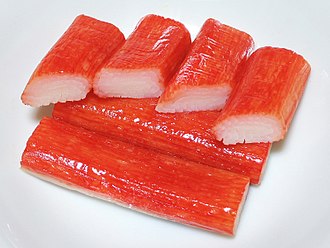Crab stick
 Crab sticks – imitation crab meat surimi. | |
| Alternative names | imitation crab meat, seafood sticks, krab |
|---|---|
| Place of origin | Japan |
| Main ingredients | white fish |
Crab sticks, krab sticks, snow legs, imitation crab meat, or seafood sticks are a Japanese seafood product made of surimi (pulverized white fish) and starch, then shaped and cured to resemble the leg meat of snow crab or Japanese spider crab.[1] It is a product that uses fish meat to imitate shellfish meat.
In Japanese, it is called kanikama (カニカマ), a portmanteau of kani ("crab") and kamaboko ("fish cake"). In the United States, it is often simply called kani.[2]
History
[edit]The Japanese company Sugiyo first produced and patented imitation crab flesh in 1974, as kanikama. This was a flake type. In 1975, the company Osaki Suisan first produced and patented imitation crab sticks.
In 1977, The Berelson Company of San Francisco, California, US, working with Sugiyo, introduced them internationally. Kanikama is still their common name in Japan, but internationally they are marketed under names including Krab Sticks, Ocean Sticks, Sea Legs and Imitation Crab Sticks. Legal restrictions now prevent them from being marketed as "Crab Sticks" in many places, as they usually do not have crab flesh.[3]
Composition
[edit]
Most crab sticks today are made from Alaska pollock (Gadus chalcogrammus) of the North Pacific Ocean.[4] This main ingredient is often mixed with fillers such as wheat, and egg white (albumen)[1] or other binding ingredient, such as the enzyme transglutaminase.[5] Crab flavoring is added (natural or more commonly, artificial) and a layer of red food coloring is applied to the outside.
Uses
[edit]Crab sticks are used in sushi, salads, fried in tempura, and many other dishes.
-
As sushi
-
As salad
-
With noodles
-
Fried as tempura
-
Mixed in potato salad
-
Wrapped in rice paper
See also
[edit]References
[edit]- ^ a b Laura, Campo-Deano; Clara Tovar (October 2009). "The effect of egg albumen on the viscoelasticity of crab sticks made from Alaska Pollock and Pacific Whiting surimi". Food Hydrocolloids. 23 (7): 1641–1646. doi:10.1016/j.foodhyd.2009.03.013.
- ^ "What is Kani? A Brief Overview - Restaurant Clicks". September 13, 2023. Archived from the original on December 8, 2023. Retrieved December 8, 2023.
- ^ "What's in a Name: Crabless Crab Legs No Longer Imitation". Wall Street Journal. December 14, 2023. Archived from the original on March 16, 2016. Retrieved August 31, 2010.(subscription required)
- ^ Mansfield, Becky (April 2003). "'Imitation crab' and the material culture of commodity production". Cultural Geographies. 10 (2): 176–195. Bibcode:2003CuGeo..10..176M. doi:10.1191/1474474003eu261oa. ISSN 1474-4740.
- ^ Gritzer, Daniel (July 22, 2008). "Mystery science eater – Time Out New York". Newyork.timeout.com. Archived from the original on August 14, 2018. Retrieved January 27, 2017.
Further reading
[edit]- Imitation crab meat. Retrieved April 18, 2014, from
- Seafood Health Facts: Making Smart Choices. Retrieved April 29, 2014 from







